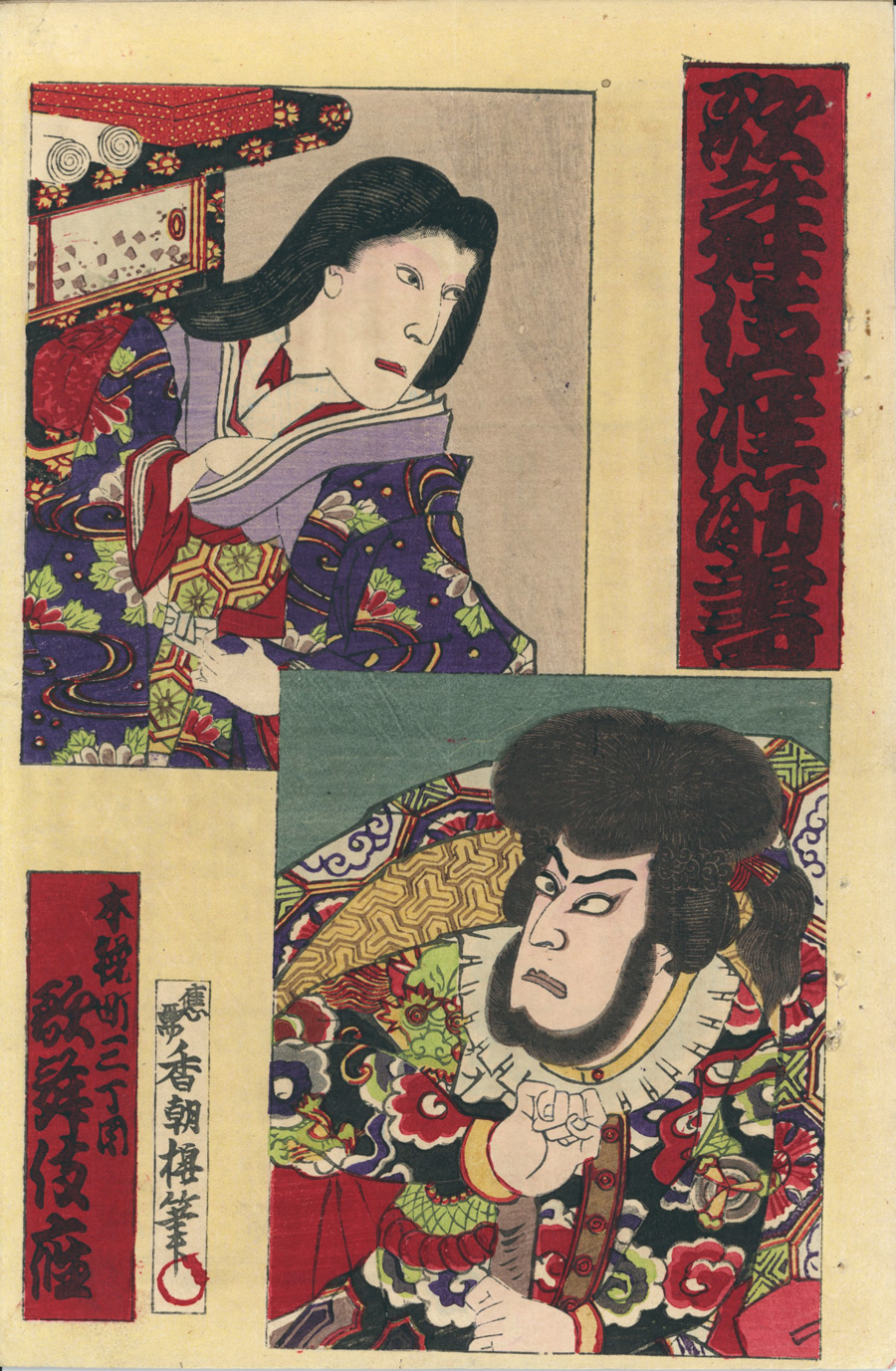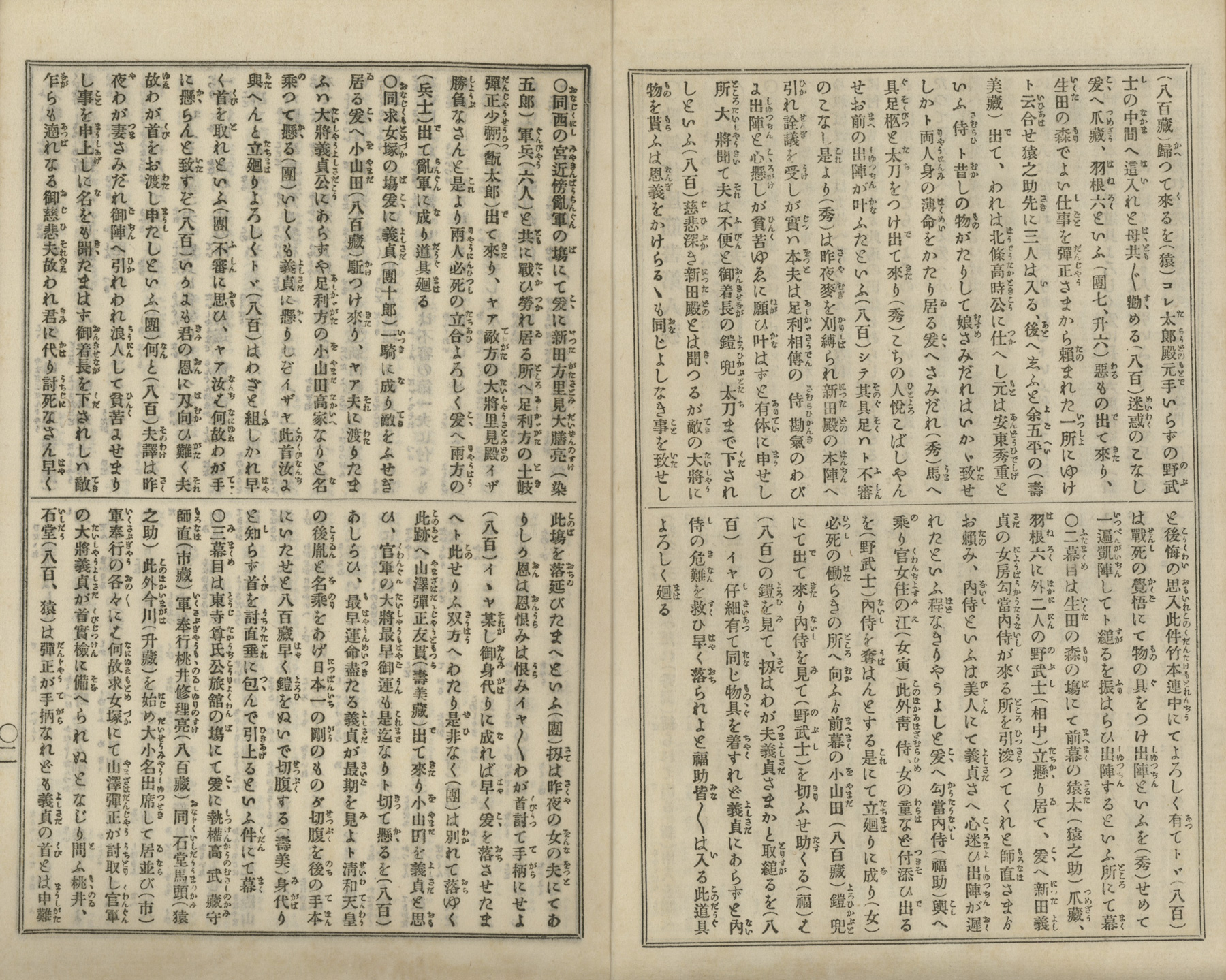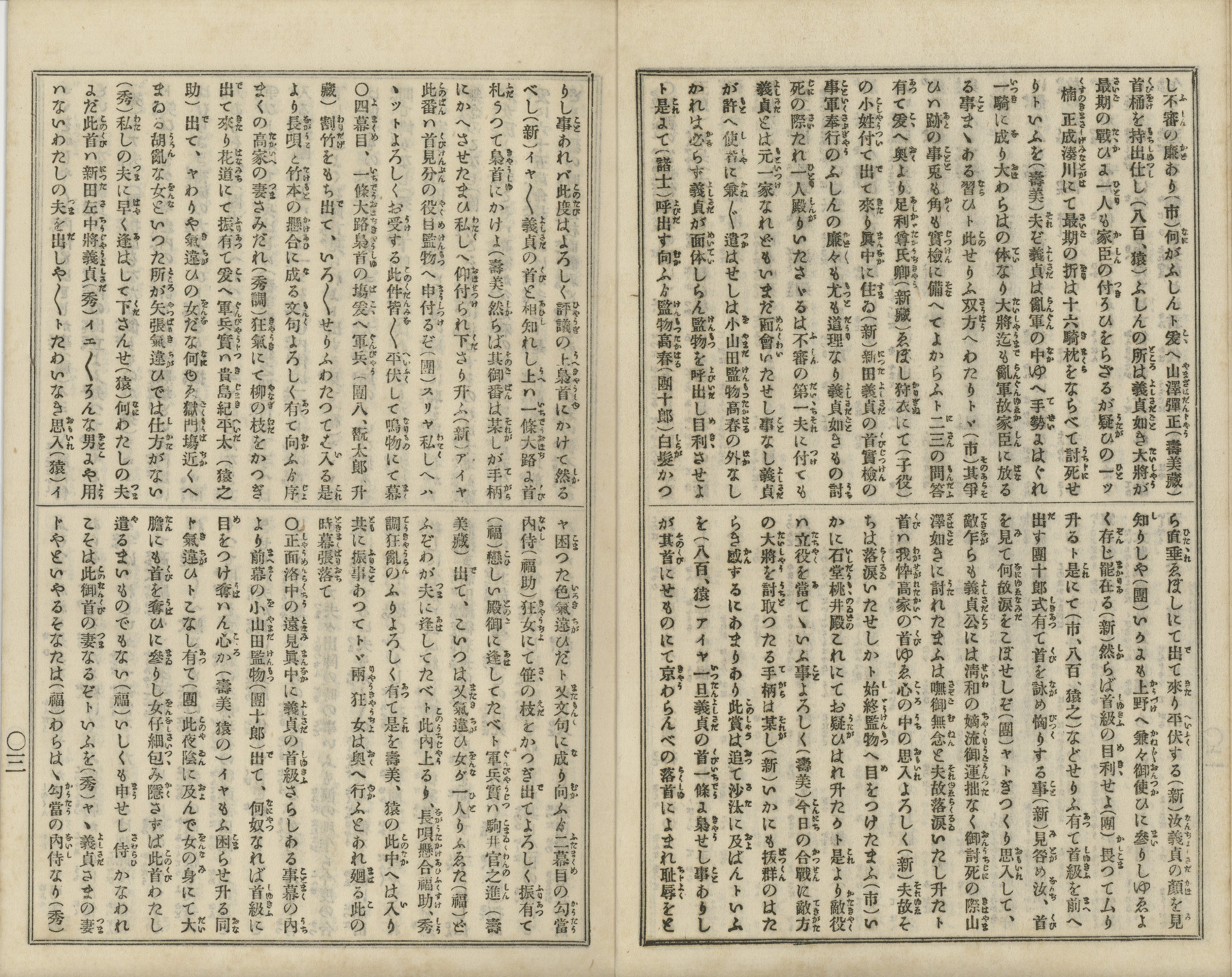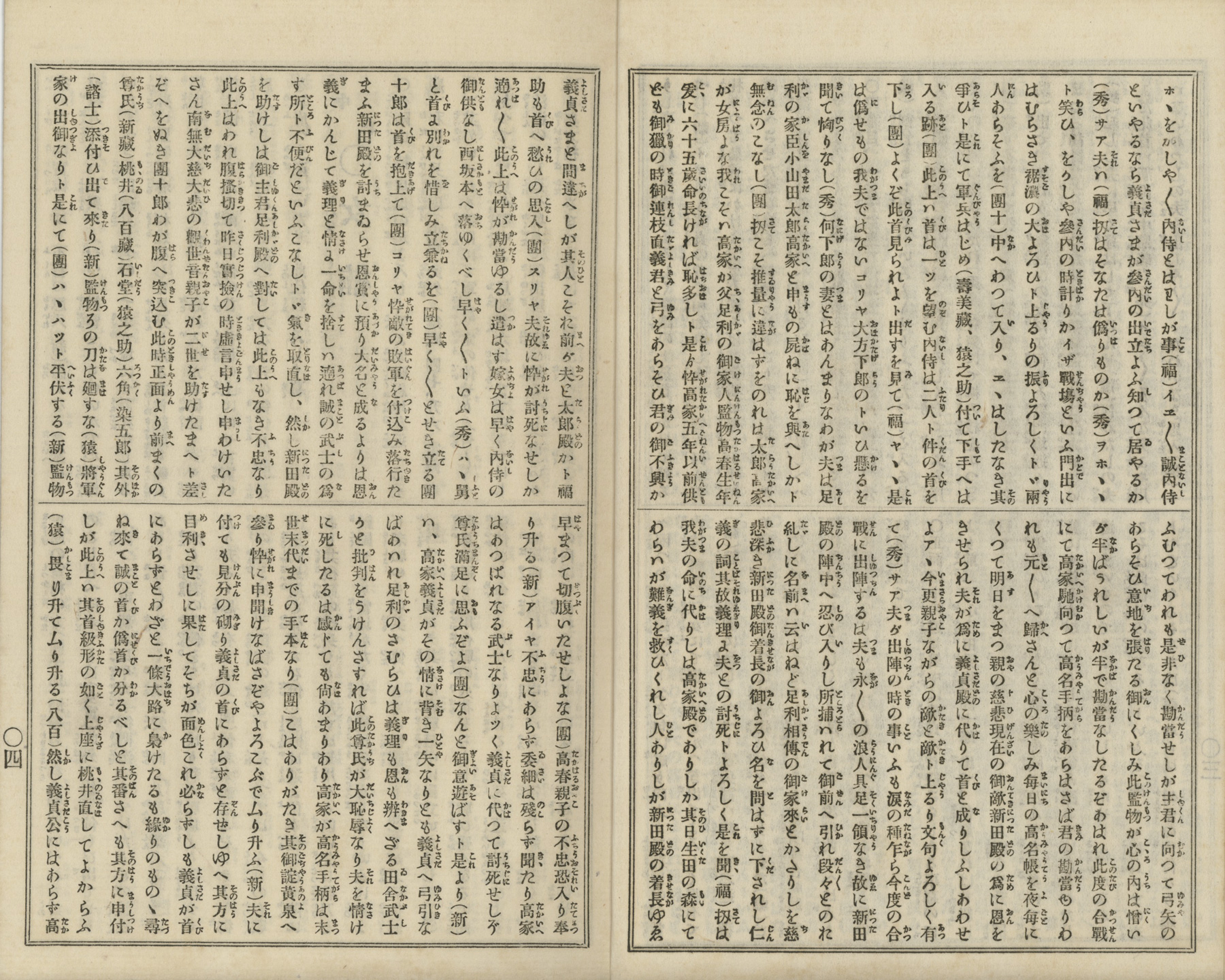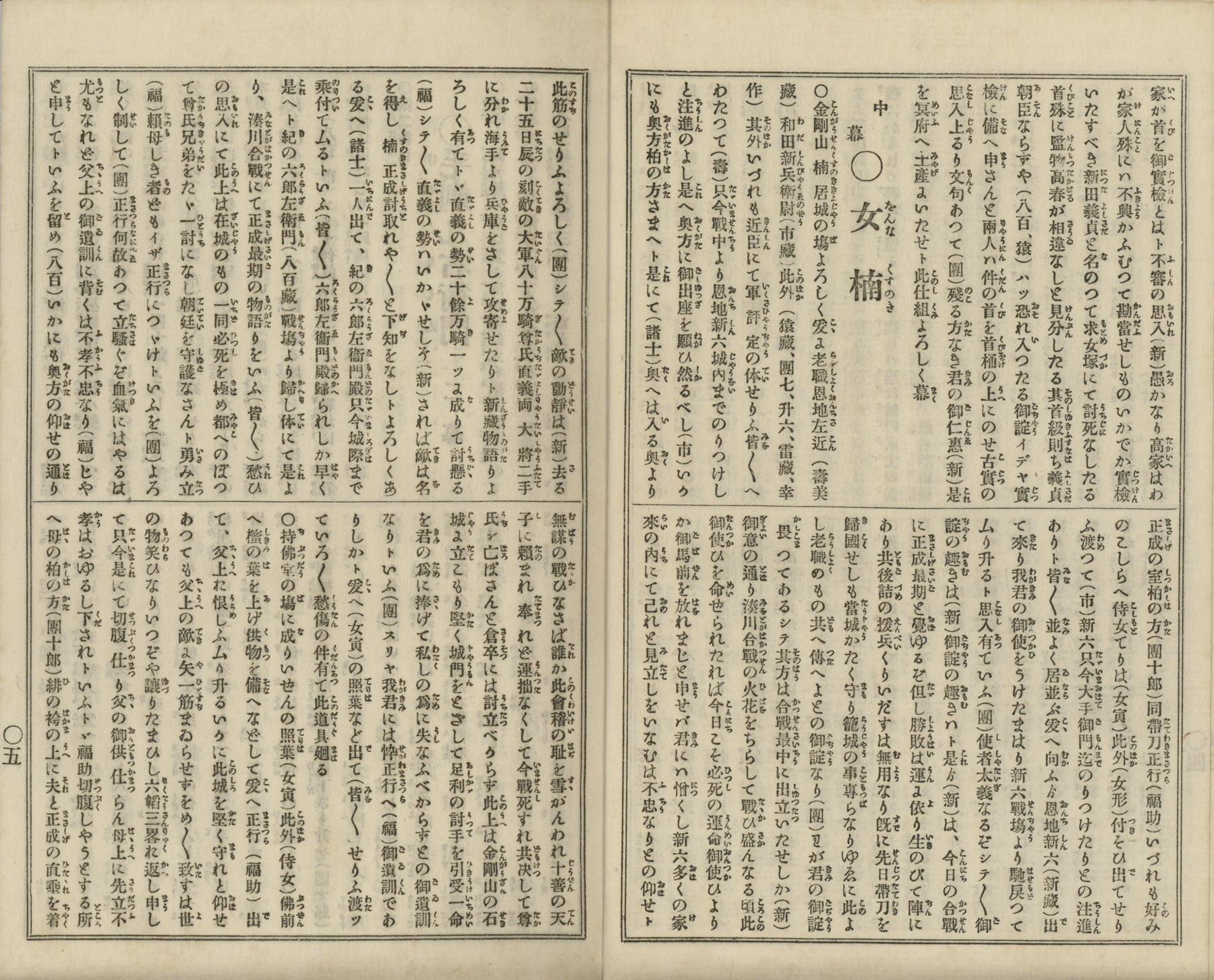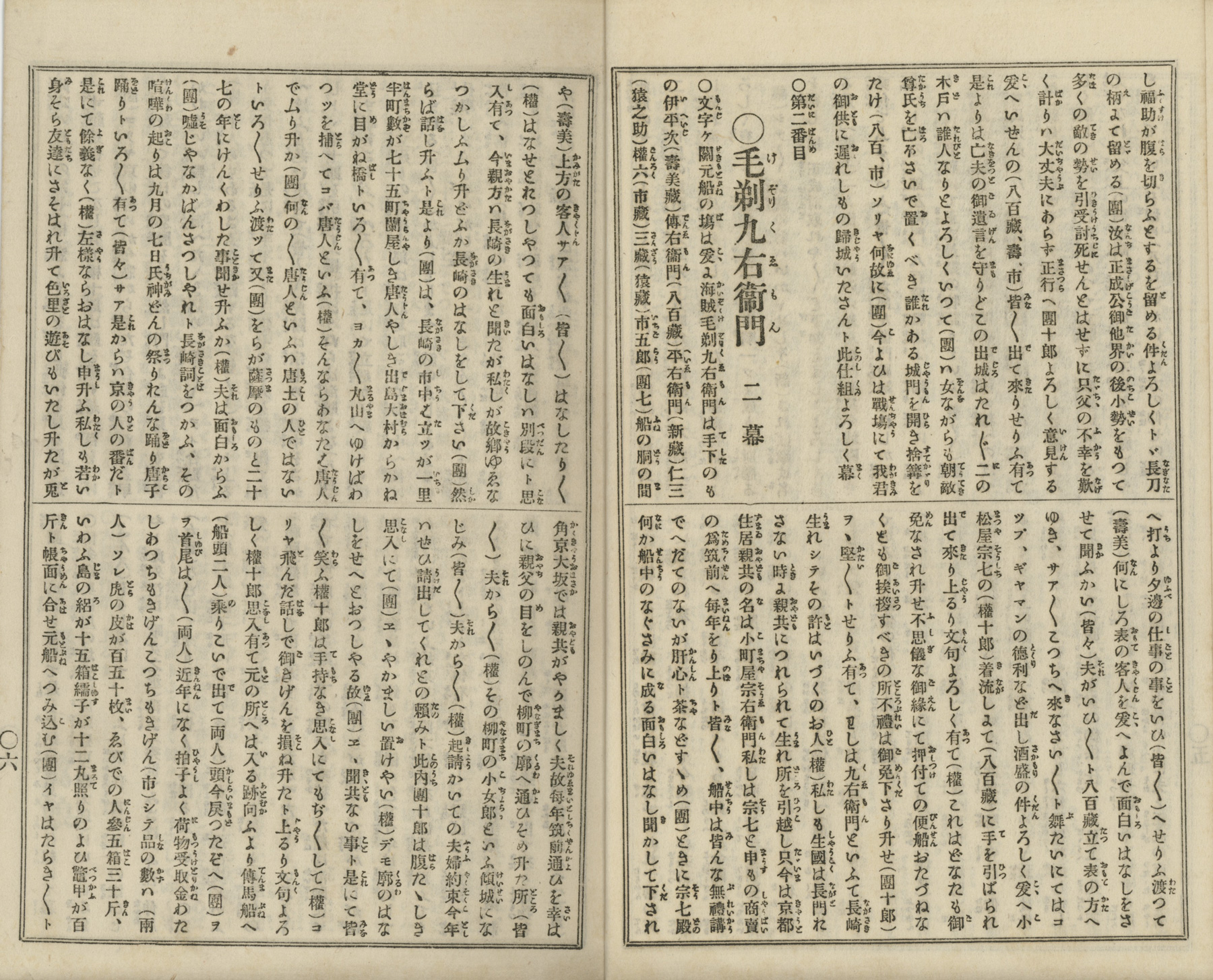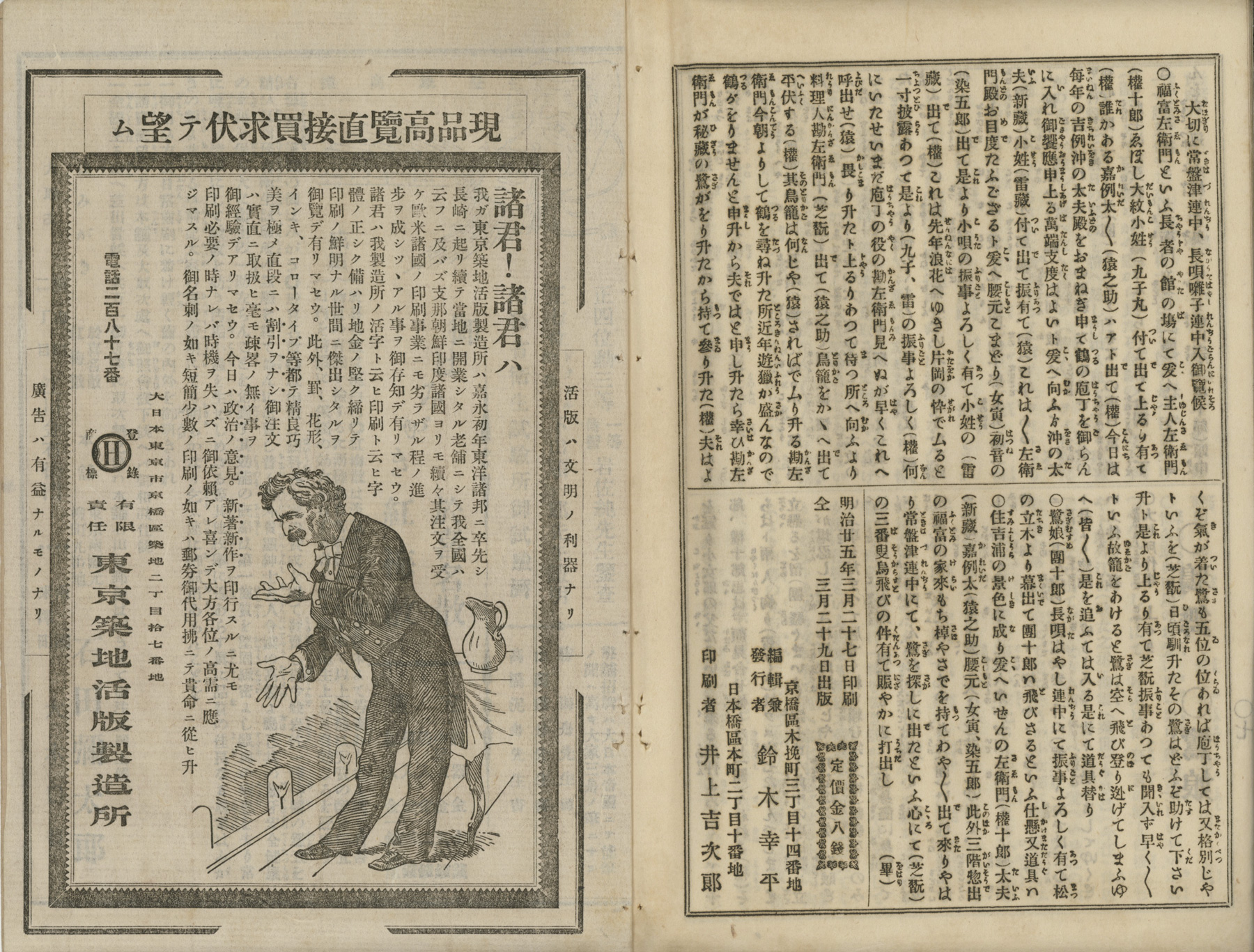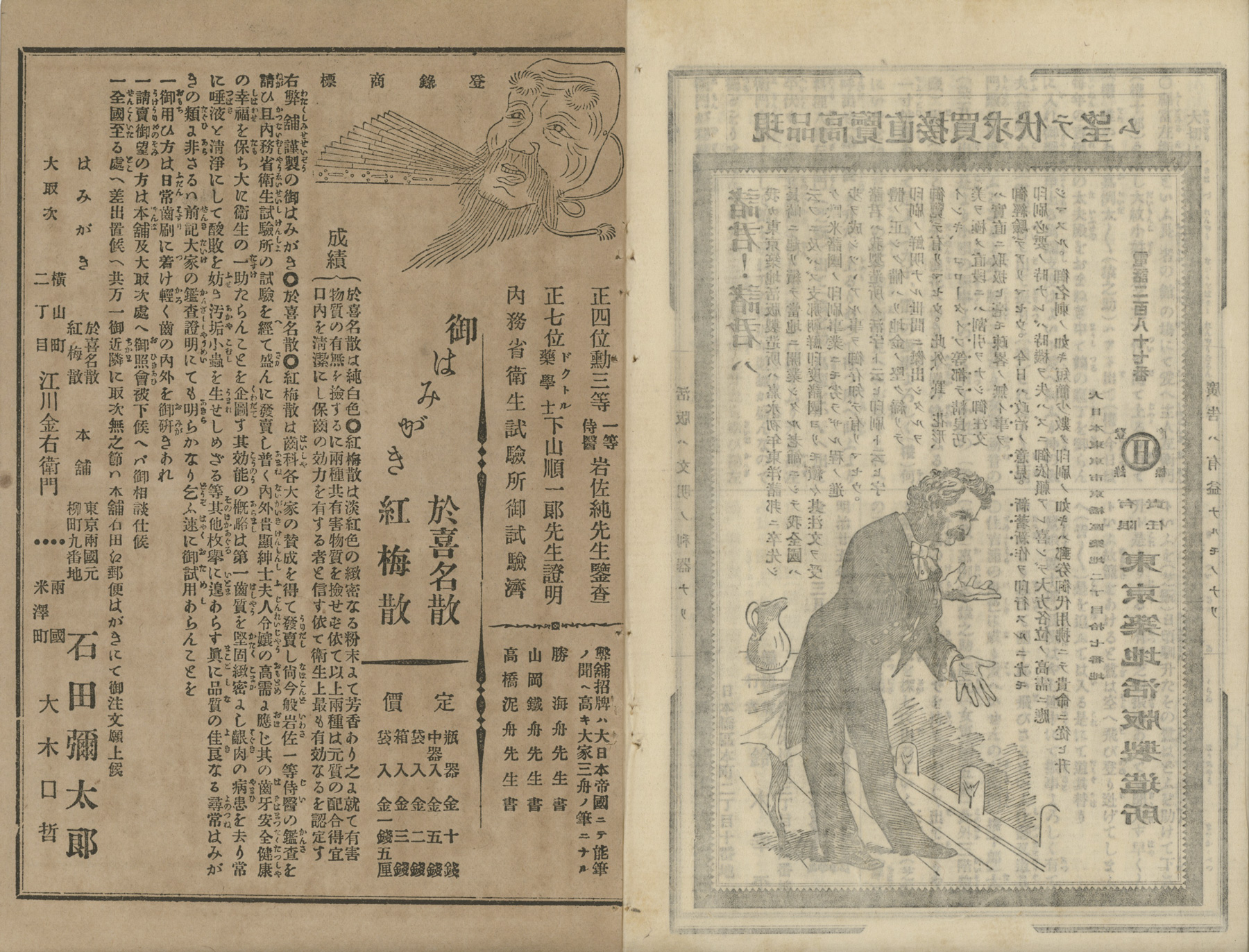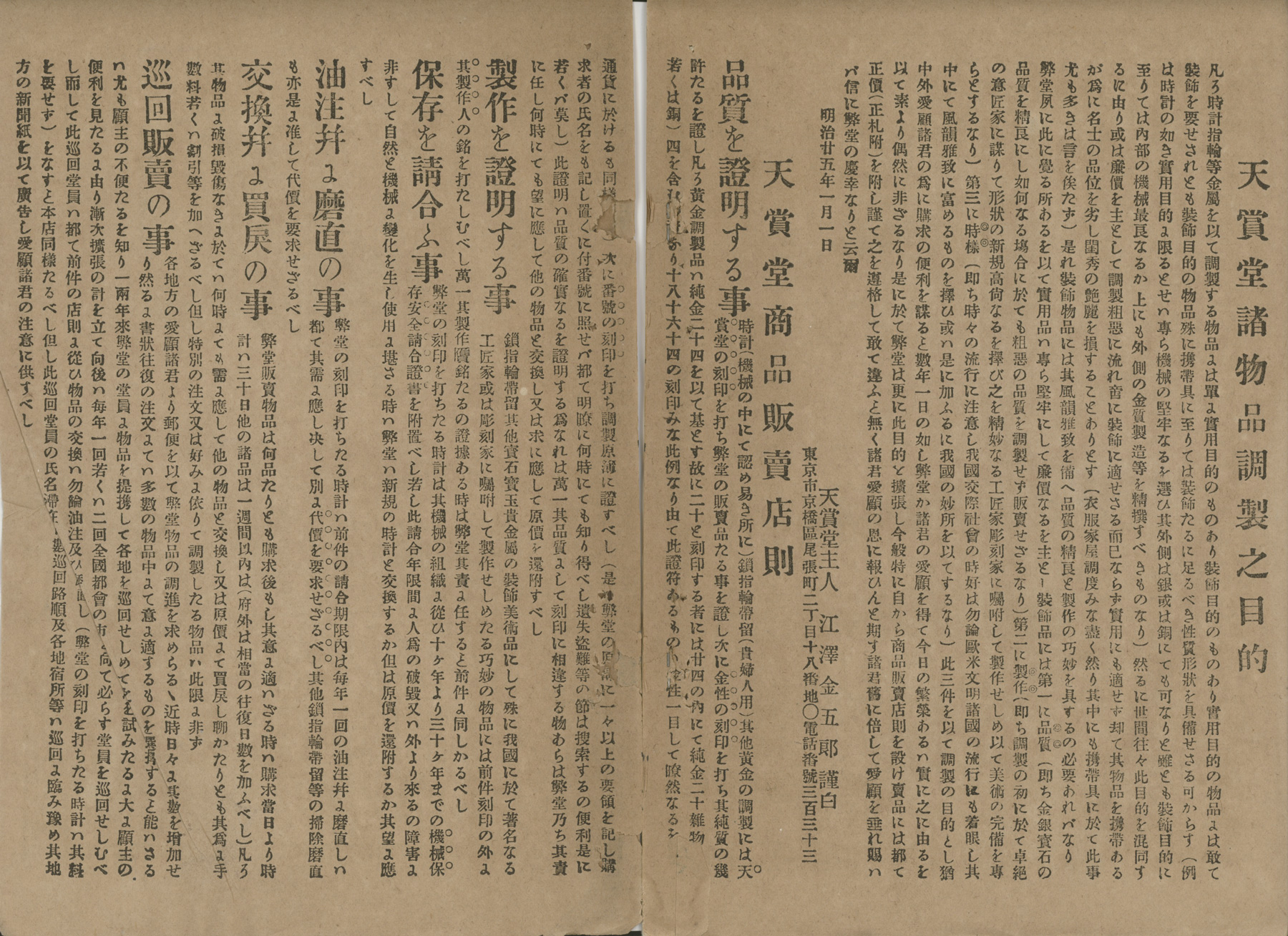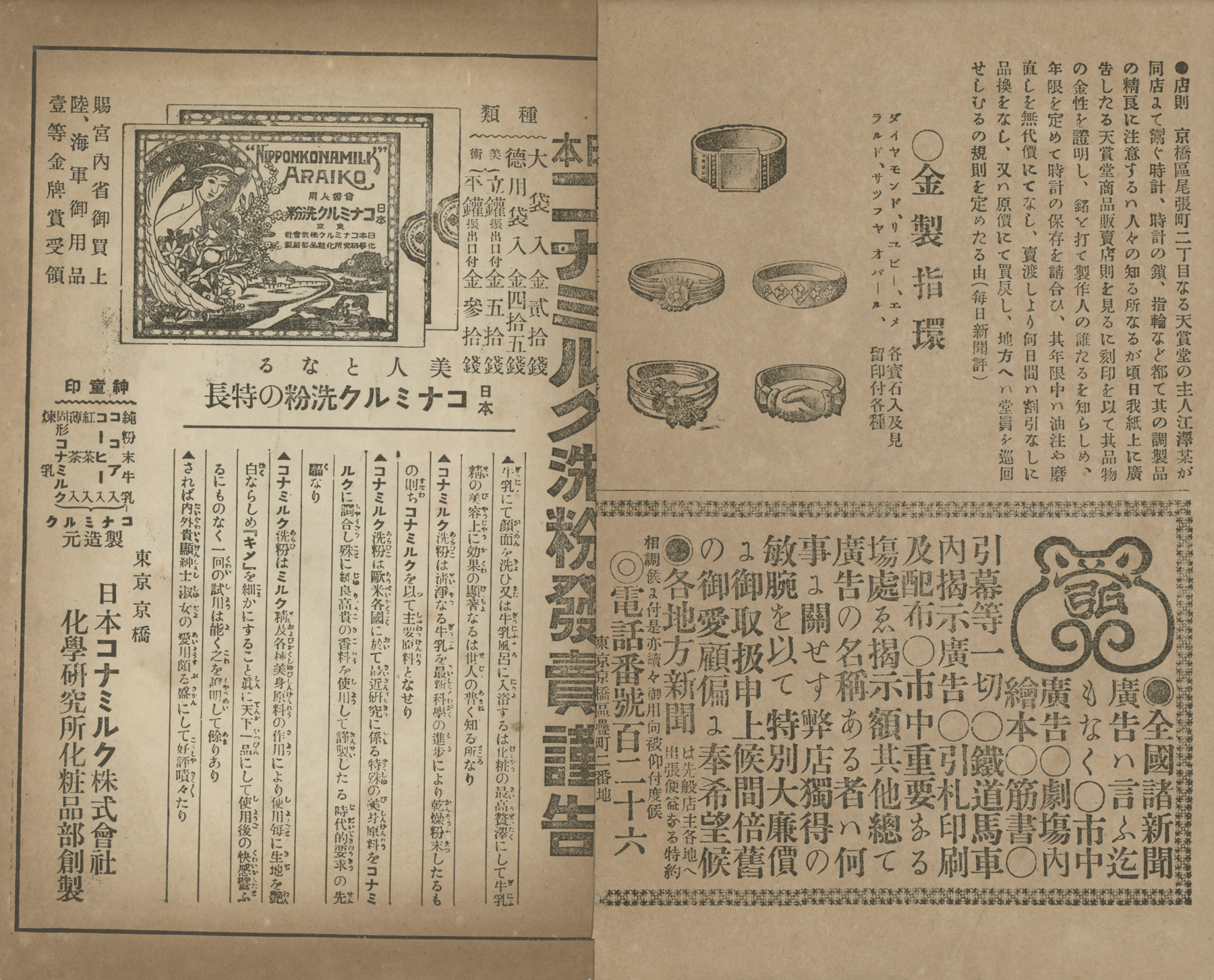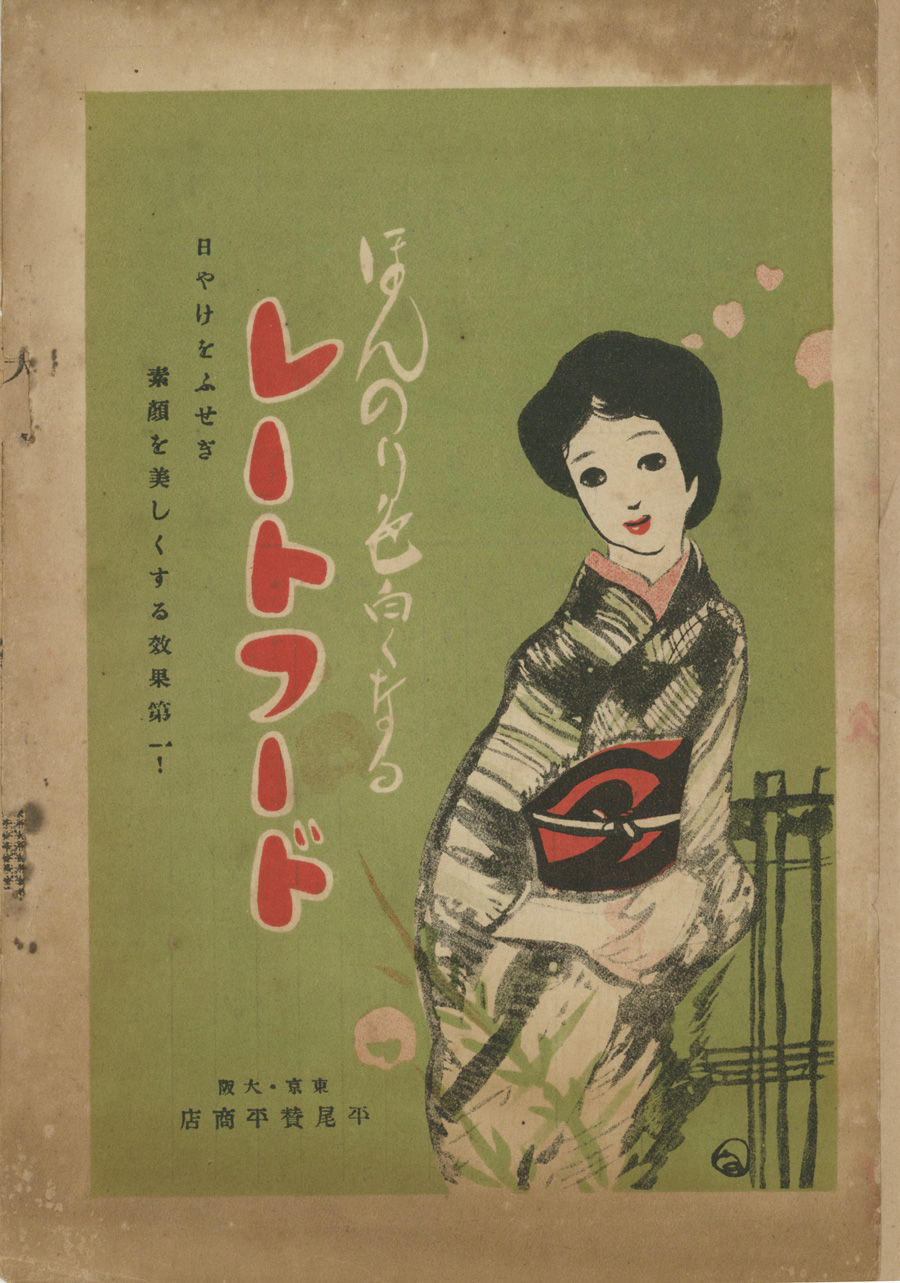About This Playbill
The cover of this kabuki playbill (ehon banzuke) from March 1892 features Ichikawa Danjūrō IX in the roles of 正成の室柏の方 (the wife of Kusunoki Masashige) in the top inset and 毛剃九右衛門 (Kezori Kyuemon) in the bottom inset. The red cartouches using kanteiryū (the scripted kanji used for kabuki signs and advertising) are difficult to decipher but seem to provide only the name of the theater, the Kabuki-za 歌舞伎座, and its location. The smaller light-colored cartouche contains the signature of the artist Utagawa Kunimasa IV, using his then current artist name Kōchōrō.The inside cover provides the lineup of actors and their roles in plays and dances for an upcoming performance. The actors' names as shown from top right to bottom left are:
役人替名 (official stage names) 市川 団十郎市川 壽美藏 市川 八百蔵 市川 新蔵 市川 猿之助 片岡 市蔵 市川 女寅 中村 福助 市川 權十郎 坂東 秀調 中村 芝翫 | Ichikawa Danjūrō IX (1838-1903) Ichikawa Sumizō V (1845-1906) Ichikawa Yaozō VII (1860-1936) Ichikawa Shinzō V (1861-1897) Ichikawa Ennosuke I (1855-1922) Kataoka Ichizō III (1851-1906) Ichikawa Metora II (1862-1914) Nakamura Fukusuke I (1831-1899) Ichikawa Gonjūrō II (1848 –1904) Bandō Shūchō I (1848-1901) Nakamura Shikan IV (1831-1899) | Roles 新田義貞 (Yoshisada Nitta), 小山田高春 (Oyamada Takaie), 正成の室柏の方 (wife of Kusunoki Masashige), 毛剃九右衛門 (Kezori Kyuemon), 鷺娘 (Sagi Musume) |
Starting on the page 1, to the left of the list of actors and their roles, are synopses of the plays. Page 1 lists the play Motomezuka migawari Nitta (求女塚身替新田), four acts (四幕). The next listed play is Onna Kusunoki (女楠), middle act (中幕), appearing on the right-hand sheet of page 5 (〇五). It is followed on the right-hand sheet of page 6 (〇六) by the play Kezori Kyuemon (毛剃九右衛門), second act (二幕). The lineup is completed on page 7 (〇七) by two dance performances 鴉舞 (crow dance?) and Sagi Musume (鷺娘), the Heron Maiden.
Information on the plays is then followed by the colophon. Publisher and printer information appears in the lower left corner along with the printing and publishing dates and the price of the playbill, 8 sen.
Dates of printing and publication: 明治廿五年三 月二十 七月印刷 (1892 Meiji 25 3rd month 27th day, printing);
三 月二十 九月出版 (3rd month, 29th day, publication)
Cost: 定價金八銭 fixed price 8 sen
Publisher and Editor (發行者 編輯): 鈴木幸平 Suzuki Kōhei followed by the publisher's address
Printer (印刷者): 井上吉次郎 (Inoue Kichijirō) followed by the printer's address
Advertisements follow the listing of plays, the first, featuring a likeness of Mark Twain addressing an audience, is an advertisement for the Tokyo Tsukiji Type Foundry, Ltd. (東京築地活版製造所 Kabushiki Kaisha Tōkyō Tsukiji Kappan Seizōsho), a large printing concern that pioneered Japanese language movable type. The text of his imaginary speech starts off with 諸君! 諸君八 ("Gentlemen and Ladies!".) Twain was a popular figure in Japan, with a number of his works being translated in the 1880s. Across the top of the ad are the kanji 現品高覽直接買求伏テ望厶, which makes reference to "top quality."
Wall Card
Japanese Kabuki Playbill
Motomezuka migawariNitta, et. al.,
Thecover of this kabuki playbill (banzuke) from March 1892 features IchikawaDanjūrō IX in the role Kusunoki Masashige’s wife in the play Onna Kusunoki (top inset) and the roleof the pirate KezoriKyuemon in the play Kezori Kyuemon (bottominset.) The red cartouches using kanteiryū (the scriptedkanji used for kabuki signs and advertising) provide the name of the theater,the Kabuki-za, and its location. The smaller light-colored cartouchecontains the signature of the artist Utagawa Kunimasa IV, using his thencurrent artist name Kōchōrō.
The inside cover provides the lineup of actorsand their roles in the upcoming plays and dances. The lineup includes the plays Motomezukamigawari Nitta in four acts;Onna Kusunoki, themiddle act; Kezori Kyuemon, thesecond act and the dance Sagi Musume, the Heron Maiden.
Information on the plays is followed by thecolophon showing the date of printing and publication, March 27, 1892; thepublisher’s name, Suzuki Kōhei (followed by his address); the printer’s nameInoue Kichijirō (followed by his address) and the cost of the playbill – 8 sen(about 50 cents in today’s dollars.)
Advertisements follow the listing of plays, thefirst, featuring a likeness of Mark Twain addressing an audience, is anadvertisement for the Tokyo Tsukiji Type Foundry, Ltd. Twainwas a popular figure in Japan, with a number of his works being translatedinto Japanese in the 1880s.
| front cover | (r) inside front cover (listing of actors and roles) (l)p. 1, (Motomezuka migawari Nitta) | p. 2 (Motomezuka migawari Nitta) 〇 二 |
| p. 6. (Kezori Kyuemon) 〇 六 | p. 7 (鴉舞 and Sagi Musume) 〇 七 | colophon and advertisement with depiction of Mark Twain |
| advertisements (金製指環, gold rings, right top Nipponkonamilk cleansing powder left page) | rear cover advertisement |
About Ehon Banzuke 絵本番付
Source: http://www.asahi.com/english/lifestyle/TKY200501220152.htmlVarious Kabuki banzuke (playbills) have different functions. Plays performed each month were announced on tsuji banzuke (street-corner posters), while ehon banzuke, similar to programs, were picture books that showed a rough outline of a play's contents and story line. Those and yakuwari banzuke (cast lists) were sold at Kabuki teahouses. The various banzuke contain an abundance of information like dates of shows, titles of plays, names of scenes, actors and theaters.
Print Details
| IHL Catalog | #730 |
| Title (Description) | Kabuki Playbill for Kabuki-za featuring the play Motomezuka migawari Nitta and the actor Ichikawa Danjūrō IX |
| Artist | Utagawa Kunimasa IV (1848-1920) |
| Signature | Ōju Kōchōrō hitsu with toshidama seal |
| Seal | Toshidama seal below signature |
| Publication Date | March 29, 1892 (Meiji 25) |
| Publisher | Suzuki Kōhei 鈴木幸平 |
| Impression | excellent |
| Colors | excellent |
| Condition | fair - inside pages toned with some folds and soiling; binding only partially intact |
| Genre | ehon banzuke |
| Miscellaneous | |
| Format | |
| H x W Paper | 8 7/8 x 5 7/8 in. (22.5 x 14.9 cm) |
| Literature | |
| Collections This Print | |


